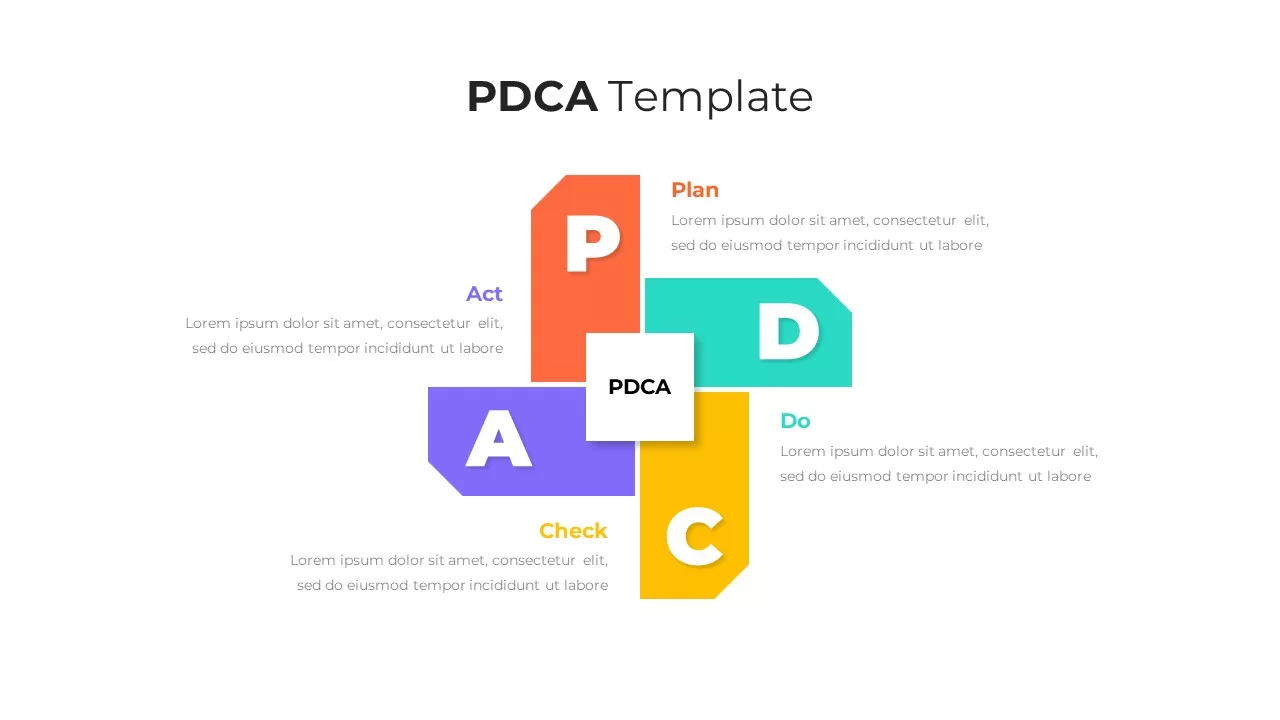PDCA Template

Description
This four-part PDCA cycle diagram slide presents a streamlined visual for the Plan-Do-Check-Act methodology. Four arrow-shaped L-blocks radiate outward from a central square labeled “PDCA,” each block rendered in a distinctive hue—orange for Plan, teal for Do, yellow for Check, and purple for Act—and inscribed with a bold initial and heading. Adjacent text placeholders link directly to each phase, providing space for concise explanations, metrics, or key action items. The slide’s geometric symmetry, softened corner cuts, and contrasting typography ensure clarity on screens and projectors alike. Every element—including colors, fonts, shapes, and icons—is editable on the master slide, enabling you to swap icons, adjust arrow angles, modify color schemes, or update text styles in seconds. The design preserves aspect ratio and alignment across PowerPoint and Google Slides, streamlining team collaboration and version control. Use the integrated slide layouts to reorder phases, scale segments, or duplicate blocks for expanded workflows without reconstructing the graphic base. This robust diagram serves as a turnkey asset for illustrating continuous improvement cycles and iterative processes.
You can further elevate engagement by applying entrance animations to each segment, staggering the appearance of Plan, Do, Check, and Act blocks to guide audience focus. The template’s built-in grouping and alignment guides ensure consistent spacing when duplicating or rearranging segments. For complex workflows, you can ungroup the arrows to add connectors, data charts, or icons, transforming the cycle into an interactive dashboard. All edits apply instantly across slide masters and content placeholders.
Who is it for
Business managers, quality engineers, and process improvement teams will benefit from this PDCA cycle diagram to structure continuous improvement initiatives, audit plans, and performance reviews. Project managers, operations leaders, and Lean practitioners can leverage the slide to communicate iterative workflows, retrospective analyses, and corrective-action strategies. Consultants, trainers, and educators will find it ideal for illustrating systematic problem-solving methods and learning loops to diverse audiences.
Other Uses
Apart from quality management, repurpose this slide for product development roadmaps, project retrospectives, and training program outlines. Adjust labels to visualize software release cycles, risk assessment loops, or KPI review schedules. The modular design also supports process audits, sustainability frameworks, and compliance tracking, enabling you to map any repetitive workflow or cyclical sequence with clarity and precision.
Login to download this file

















































